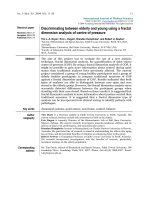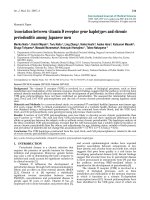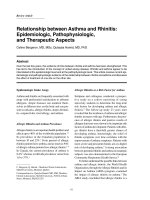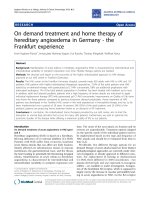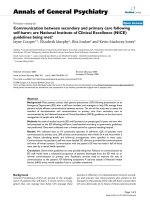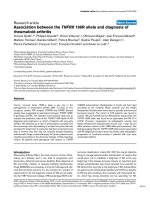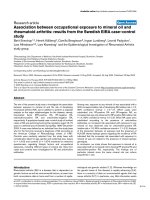Báo cáo y học: "Association between expatriation and HIV awareness and knowledge among injecting drug users in Kabul, Afghanistan: A cross-sectional comparison of former refugees to those remaining during conflict" ppsx
Bạn đang xem bản rút gọn của tài liệu. Xem và tải ngay bản đầy đủ của tài liệu tại đây (242.98 KB, 8 trang )
BioMed Central
Page 1 of 8
(page number not for citation purposes)
Conflict and Health
Open Access
Research
Association between expatriation and HIV awareness and
knowledge among injecting drug users in Kabul, Afghanistan: A
cross-sectional comparison of former refugees to those remaining
during conflict
Catherine S Todd*
1
, Abdullah MS Abed
2
, Steffanie A Strathdee
1
,
Paul T Scott
3
, Boulos A Botros
4
, Naqibullah Safi
2
and Kenneth C Earhart
4
Address:
1
Division of International Health & Cross-cultural Medicine, University of California, San Diego School of Medicine, 9500 Gilman Drive,
La Jolla, California, USA 92093-0622,
2
National AIDS Control Program; Ministry of Public Health; Great Massoud Circle, Kabul, Afghanistan,
3
United States Military HIV Research Program/Division of Retrovirology, Walter Reed Army Institute of Research; 1 Taft Court, Suite 250; Rockville,
Maryland, USA 20850 and
4
Virology Research Program, United States Naval Medical Research Unit 3; Ramses Extension Street near Abbasia Fever
Hospital; Abbassia, Cairo, Egypt
Email: Catherine S Todd* - ; Abdullah MS Abed - ; Steffanie A Strathdee - ;
Paul T Scott - ; Boulos A Botros - ; Naqibullah Safi - ;
Kenneth C Earhart -
* Corresponding author
Abstract
Background: Little is known about human immunodeficiency virus (HIV) awareness among
Afghan injecting drug users (IDUs), many of whom initiated injecting as refugees. We explored
whether differences in HIV awareness and knowledge exist between Afghan IDUs who were
refugees compared to those never having left Afghanistan.
Methods: A convenience sample of IDUs in Kabul, Afghanistan was recruited into a cross-sectional
study through street outreach over a one year period beginning in 2005. Participants completed an
interviewer-administered questionnaire and underwent voluntary counseling and testing for HIV,
syphilis, hepatitis B surface antigen, and hepatitis C antibody. Differences in HIV awareness and
specific HIV knowledge between IDU who lived outside the country in the last decade versus those
who had not were assessed with logistic regression.
Results: Of 464 IDUs, 463 (99%) were male; median age and age at first injection were 29 and 25
years, respectively. Most (86.4%) had lived or worked outside the country in the past ten years.
Awareness of HIV was reported by 46.1%; those having been outside the country in the last decade
were significantly more likely to have heard of HIV (48.3% vs. 31.7%; OR = 2.00, 95% CI: 1.14 –
3.53). However, of those aware of HIV, only 38.3% could name three correct transmission routes;
specific HIV knowledge was not significantly associated with residence outside the country.
Conclusion: Accurate HIV knowledge among Afghan IDUs is low, though former refugees had
greater HIV awareness. Reported high-risk injecting behavior was not significantly different
between IDU that were refugees and those that did not leave the country, indicating that all Afghan
IDU should receive targeted prevention programming.
Published: 21 March 2007
Conflict and Health 2007, 1:5 doi:10.1186/1752-1505-1-5
Received: 22 January 2007
Accepted: 21 March 2007
This article is available from: />© 2007 Todd et al; licensee BioMed Central Ltd.
This is an Open Access article distributed under the terms of the Creative Commons Attribution License ( />),
which permits unrestricted use, distribution, and reproduction in any medium, provided the original work is properly cited.
Conflict and Health 2007, 1:5 />Page 2 of 8
(page number not for citation purposes)
Background
Military conflict frequently results in the displacement of
large numbers of people, often to neighboring countries.
The link between spread of human immunodeficiency
virus (HIV) and population migration is controversial [1-
3]; however, post-conflict populations have been identi-
fied as being at particular risk of HIV acquisition due to
vulnerabilities created by displacement, lack of HIV
knowledge, and tendencies to engage in riskier behaviors
[4-7]. International literature suggests that refugees have
comparatively less knowledge about HIV and engage dis-
proportionately in high risk behaviors compared to their
counterparts who remain in the country [7-10]. However,
there has been little scrutiny of whether exposure to a set-
ting of greater knowledge of HIV and other blood-borne
infections results in transferred knowledge among those
who repatriate to their country of origin.
Afghanistan is currently a fragile state, still reeling from
the effects of nearly thirty years of civil war and current
political instability in several regions of the country [11].
While Afghanistan is considered a low HIV prevalence
country, there have been few assessments of HIV knowl-
edge [12]. Measuring the knowledge of HIV and ability to
identify and access tools for prevention is pertinent for
Afghanistan due to factors that may result in a concen-
trated epidemic among injecting drug users (IDU). Iran,
Pakistan, Uzbekistan, Tajikistan, and western China are
all experiencing rapid increases in HIV prevalence among
IDU in multiple cities [3]. Approximately six million
Afghans were displaced to these countries, particularly
Iran and Pakistan, during the last three decades of conflict
[13]. The number of IDUs in Afghanistan is believed to be
increasing, possibly due to learned injecting behaviors
from countries of refuge [14]. In Pakistan, Afghan IDU
were found to have less HIV knowledge than their Paki-
stani counterparts,[9] but no comparison has been per-
formed between IDU who were refugees and those not
leaving the country.
The purpose of this paper is to examine whether displace-
ment outside Afghanistan is associated with knowledge of
HIV and other blood-borne infections among IDU in
Kabul, Afghanistan. This information is important
because it indicates the penetration of HIV awareness and
harm reduction programming in both Afghanistan and in
neighboring countries within this high risk and poten-
tially marginalized group and the accuracy of messages
intended for this group. This manuscript reports the asso-
ciation between residence outside Afghanistan and HIV
awareness and knowledge and assesses the level of accu-
rate HIV knowledge among IDUs in Kabul between 2005
and 2006.
Methods
Study Design and Participants
This cross-sectional study was conducted in Kabul, the
capital of Afghanistan, between June, 2005 and June,
2006. All study activities occurred at the Voluntary Coun-
seling and Testing (VCT) Center at the Central Polyclinic,
an Afghan Ministry of Public Health facility, with partici-
pants referred through outreach personnel already work-
ing with the drug-using community. Eligible participants
were those reporting injecting drugs within the past six
months (confirmed through injection stigmata), aged 18
years or greater, and able to provide informed consent.
Prior to enrollment, the research study was approved by
the investigational review boards of the Afghan Ministry
of Public Health; the University of California, San Diego;
the United States Naval Medical Research Unit No. 3; and
the Walter Reed Army Institute of Research.
Measurement of variables and outcomes of interest
The questionnaire included questions pertaining to socio-
demographics, travel, incarceration, and medical histo-
ries, and drug use and sexual behaviors. Time outside the
country was first assessed with a general question: "Have
you lived/worked outside Afghanistan for any period of
time in the last 10 years?" Those responding affirmatively
were asked to define the time period of expatriation by the
government in power at the time of leaving the country:
during the Russian occupation (1979–1989), during
Najibullah and the mujaheddin (1989 – 1995), during
the Taliban (1996 – 2001), or during the military action
deposing the Taliban (2001 – 2003). Country of displace-
ment and reason(s) for leaving were also assessed with
multiple responses allowed.
The outcome of interest, awareness of HIV infection, was
assessed with the question,"Have you ever heard of HIV?."
Knowledge about HIV was gauged through one open-
ended (e.g. "List the ways you know that HIV is spread")
and twelve true/false questions which included assess-
ment of: transmission routes (e.g."Which of the following
activities can result in HIV infection: mosquito bites, sex-
ual intercourse, hugging/kissing"), longevity and treat-
ment for HIV (e.g. "There are medicines that can cure a
person of their HIV infection"), and means of prevention
(e.g."When it comes to getting HIV from sexual inter-
course, using a condom is a good way to reduce your
chance of getting HIV").
Procedures
Potential participants were accompanied to the VCT
Center by an outreach worker or other IDU of their
acquaintance. At the center, trained study representatives
matched to participant gender explained the study in a
confidential setting, obtained informed consent, adminis-
tered the questionnaire by interview, and performed sero-
Conflict and Health 2007, 1:5 />Page 3 of 8
(page number not for citation purposes)
logic testing. Each participant was assigned a unique study
number. No data was recorded on those declining or inel-
igible for study entry.
Pre- and post-test counseling and rapid whole blood test-
ing for HIV, syphilis, hepatitis C antibody, and hepatitis B
surface antigen testing was subsequently performed with
positive tests undergoing confirmation on site. All partic-
ipants received risk reduction counseling, condoms and
sterile syringes, with referrals for detoxification and nee-
dle and syringe programs (NSPs) upon request.
Statistical Analysis
The outcomes of interest for this analysis were familiarity
with and correct knowledge of HIV among those IDU hav-
ing left Afghanistan compared to those having not left in
the last decade. Our sample size was sufficient to detect at
least an 18% difference in HIV awareness or knowledge
between those having left Afghanistan within the last dec-
ade and those not having left the country (power = 80,
two-sided alpha = 0.05). To measure familiarity with HIV,
the dichotomous variable HIV awareness was utilized
with a yes or no response. Correct transmission knowl-
edge was defined as three correct responses and no incor-
rect responses to reported modes of transmission.
Continuous variables, such as age of initiating injection
use, were transformed to dichotomous variables using the
median age as the cut-off point. Univariate logistic regres-
sion was performed to identify potential differences in
demographics and high risk behaviors between IDU who
had left Afghanistan ever and in the last decade. Logistic
regression was performed to test for associations between
HIV familiarity and knowledge and time outside the
country. A separate logistic regression analysis was per-
formed to determine whether length of time outside the
country, a categorical variable with time outside the coun-
try increasing with ascending number, affected the
strength of association between variables related to expa-
triation.
Results
A total of 464 IDU participated in this study, of whom the
majority were male (n = 463) and Afghan (n = 459). Most
(86.4%, n = 400) had lived or worked outside the country
in the past ten years, with war (80.7%, n = 338; multiple
responses permitted), work (15.5%, n = 65), political
repression (1.2%, n = 5), education (0.7%, n = 3), or other
factors (1.9%, n = 8) cited as reasons for leaving the coun-
try. The majority of participants moved during the Taliban
regime (50.1%), with 31.9% leaving during Najibullah's
leadership (1989 – 1995), 15.3% leaving during the Rus-
sian invasion, and 2.4% leaving at the time of United
States-led military activity against the Taliban. Many
(37.7%) had been to more than one country during peri-
ods of expatriation, with Iran being the most popular
country of refuge (61.3%), followed by Pakistan (32.3%)
and other countries, including India, the Arab Emirates,
and Tajikistan (6.4%).
The prevalence and correlates of having left Afghanistan
in the last decade are displayed in Table 1. Generally,
those who resided outside Afghanistan were less likely to
report using a new needle with each injection and margin-
ally more likely to report prior condom use (Table 1). The
association between using a new needle with each injec-
tion never having left Afghanistan persisted after adjust-
ment for potential confounders of prior incarceration and
monthly earnings (AOR = 0.51, 95% CI: 0.21 – 0.88).
IDU who reported never having left Afghanistan (9.3%, n
= 43) did not differ significantly from those who had ever
left the country (data not shown).
Awareness of HIV was reported by 46.1% (n = 214) of par-
ticipants; IDU having been outside the country in the last
decade were significantly more likely to have heard of HIV
(48.3% vs. 31.7%; OR = 2.00, 95% CI: 1.14 – 3.53). This
relationship remained significant when analyzed with
potential confounders of educational level, prior incarcer-
ation, and monthly income level (AOR = 2.08, 95% CI:
1.16 – 3.72). Country of refuge was not significantly asso-
ciated with HIV awareness; however, duration of expatria-
tion was marginally positively associated with HIV
awareness (OR = 1.27, 95% CI: 0.98 – 1.65).
Among those aware of HIV, residence outside the country
in the last decade did not affect the source of information
about HIV (friends, p = 0.89; TV/print media, p = 0.34;
medical personnel, p = 0.66; or addiction treatment cent-
ers, p = 0.27). Of those aware of HIV, 95.3% (n = 204)
claimed knowledge of routes of transmission. However,
when asked to name transmission routes, only 38.3% of
those aware of HIV were able to provide three correct and
no incorrect responses, which was not associated with
having lived outside the country in the last decade (p =
0.89; OR = 0.93, 95% CI: 0.36 – 2.39). Duration spent
outside the country was inversely associated with ability
to name three correct transmission routes (OR = 0.64,
95% CI: 0.43 – 0.95).
No significant differences in specific HIV knowledge con-
tent areas emerged between IDUs living outside Afghani-
stan in the last decade and IDUs who remained within the
country; however, the low numbers in each group reduced
statistical power considerably (Table 2). For participants
who had ever resided outside of Afghanistan, the level of
specific HIV knowledge was assessed according to the
duration of time spent outside the country. Knowledge
that using new needles with each injection reduce HIV
risk, that HIV is infectious forever, or, marginally, that HIV
may be transmitted by donated blood was positively
Conflict and Health 2007, 1:5 />Page 4 of 8
(page number not for citation purposes)
related to length of time outside the country, while know-
ing that HIV is not transmitted by hugging/kissing, mos-
quito bites, or lack of hygiene was inversely related to time
outside the country (Table 3).
Discussion
In 2005, Afghans represented the largest group of refugees
globally with an estimated remaining total of 1.9 million,
despite the repatriation of an estimated three million peo-
ple between 2002 and 2004 [15-17]. While HIV aware-
ness among Afghan refugee drug users living in Pakistan
has been previously assessed,[9] this is the first study to
our knowledge to examine potential differences in HIV
knowledge between repatriated Afghans and those who
did not leave the country. We detected a statistically signif-
icant difference in levels of HIV awareness between those
IDU having lived outside the country and those not leav-
ing Afghanistan; however, correct HIV knowledge was low
and risky injecting practices were common for both
groups, foreshadowing a public health catastrophe should
HIV transmission accelerate within this population.
Nearly half of IDU surveyed in Kabul were aware of HIV,
consistent with the 57% of IDU aware of HIV surveyed in
Kabul and Herat in 2004–2005 by Action Aid.(personal
communication, Dr. J. Foran) Awareness of HIV among
IDU in this study was considerably higher than the 4.3%
measured among Afghan drug-using refugees residing in
Quetta in 2001 [9]. In a study assessing HIV and hepatitis
C prevalence and correlates among drug users in Pakistan
in 2003, 63.2% of Afghan drug users surveyed in Quetta
were aware of HIV compared to 82.8% of Pakistani drug
users (p < 0.001).(Personal communication, Dr. I. Kuo)
This interval change for both Afghan and Pakistani drug
users in two years may reflect greater emphasis on pro-
gramming for drug users in Pakistan, perhaps in response
to HIV outbreaks among IDU in several Pakistani cities
detected during that time period [3]. These data must be
interpreted with caution as both studies were cross-sec-
tional and involve different individuals.
The greater HIV awareness among those who had lived or
worked outside Afghanistan in the last decade may be
attributed to increased public and IDU-focused education
efforts in Iran and Pakistan, the countries which provided
refuge to the majority of Afghans during the wars and cur-
rently experiencing concentrated HIV epidemics among
IDU in several sites [3,18]. Longer duration of time out-
Table 1: Correlates of living outside Afghanistan in the last decade among injecting drug users in Kabul (n = 463).
Variable Non-refugee last decade, N, % Refugee last decade, decade, N, % O.R., 95% CI
Age (n = 463): 1.02, 0.59 – 1.76
≤ 30 years 38, (60.3%) 239, (59.8%)
> 30 years 29, (39.7%) 161, (40.3%)
Civil Status (n = 463): 1.06, 0.62 – 1.80
Married 32, (50.8%) 209, (52.3%)
Educational Level (n = 463): 0.96, 0.50 – 1.86
≤ 8 years 50, (79.4%) 320, (80.0%)
> 8 years 13, (20.6%) 80, (20.0%)
Monthly Income (n = 463): 0.65, 0.38 – 1.11
≤ 4900 Afghanis 37, (58.7%) 275, (68.8%)
> 4900 Afghanis 26, (46.3%) 125, (31.3%)
Duration of Injecting (n = 463): 1.27, 0.74 – 2.18
≤ 3 years 38, (60.3%) 218, (54.5%)
> 3 years 25, (39.7%) 182, (45.5%)
Age Initiated Injecting (n = 463): 1.12, 0.66 – 1.92
< 26 years 36, (57.1%) 217, (54.3%)
> 26 years 27, (42.9%) 183, (45.8%)
Receptive Needle Sharing in Last Six Months (n = 463): 0.98, 0.55 – 1.77
Yes 18, (28.6%) 113, (28.3%)
Distributive Needle Sharing in the Last Six Months (n = 463): 1.02, 0.57 – 1.84
Yes 18, (28.6%) 116, (29.0%)
Always Use New Needle With Each Injection (n = 462): 0.49, 0.29 – 0.85
Yes 27, (42.9%) 108, (27.1%)
Ever Use Condoms (n = 431): 2.28, 0.94 – 5.50
Yes 6, (10.5%) 79, (26.8%)
Ever Incarcerated (n = 463): 1.00, 0.59 – 1.72
Yes: 36, (57.1%) 229, (57.1%)
Inject Drugs in Jail (n = 265): 1.26, 0.42 – 2.09
Yes 10, (31.3%) 66, (29.9%)
Conflict and Health 2007, 1:5 />Page 5 of 8
(page number not for citation purposes)
side the country was marginally associated with HIV
awareness, possibly reflecting integration of long-term ref-
ugees with the host society leading to increased access to
health care and HIV information. The lack of access to
health services and differences in language, which may be
overcome with acculturation during a longer duration of
residence, were noted to be barriers to HIV knowledge
acquisition in recent studies among African refugees resid-
ing in the United States and Denmark [10,19].
There was some parity between knowledge and behavior
as IDU living outside Afghanistan in the last decade were
more likely to have used a condom; however, they were
less likely to use new syringes with each injection. In
Afghanistan and Iran, disposable syringes may be pur-
chased from pharmacies legally and at low cost [20].
However, in Pakistan, repackaging, sale, and use of previ-
ously-used syringes is attributed to high prevalence of
hepatitis B and C [21,22]. The widespread knowledge of
this risk may prevent IDUs from purchasing syringes but
instead promote sharing by obtaining syringes from
within their social network [23]. Alternatively, harm
reduction programming within Afghanistan may have
accessed more IDU or better communicated the need to
use new needles with each injection. Though this compar-
ison did not reach statistical significance, IDU not having
left Afghanistan more frequently stated that using a new
needle/syringe with each injection would reduce risk of
HIV than those who lived in other countries within the
last decade.
Awareness of HIV did not necessarily reflect accurate
knowledge about HIV and many IDU were unable to sup-
ply correct responses to specific knowledge questions.
While it is reassuring that most IDU correctly identified
used needles and sexual intercourse as routes of infection
in true/false questions, it is more concerning that less than
60% were able to definitively state that using a new needle
with each injection or using a condom could reduce the
risk of HIV transmission. Additionally, those living out-
side the country in the last decade were not more likely to
have knowledge about modalities of HIV prevention,
indicating that prevention and education efforts, both in
Afghanistan and neighboring countries, are not reaching
the most vulnerable populations.
This study has several limitations that must be considered.
First, due to convenience sampling, the results may not be
generalizable to all IDU in Kabul. Next, the interview for-
mat may have resulted in socially-desirable response on
HIV awareness and reported high risk behaviors. We
attempted to minimize this by having an interviewer of
the same gender and administering the questionnaire
prior to pre-test counseling. Last, as many participants
sought refuge in multiple countries, we cannot defini-
tively ascertain degree of knowledge imparted in a specific
Table 2: Differences in correct HIV knowledge among injecting drug users (IDUs) in Kabul, Afghanistan (n = 214).
Question Topic Overall Live in Afg. > 10 yrs n,(%) Lived Outside Afghanistan n,(%) OR, 95% CI
HIV infectious forever: 0.66, 0.26 – 1.66
97, (45.5%) 11, (55.0%) 86, (44.6%)
HIV can not be detected just by looking at a person 1.43, 0.55 – 3.74
91, (42.7%) 7, (35.0%) 84, (43.5%)
Medicines cannot cure HIV 0.86, 0.33 – 2.26
68, (31.9%) 7, (35.0%) 61, (31.6%)
Used needles transmit HIV 0.60, 0.17 – 2.13
166, (71.9%) 17, (85.0%) 149, (77.2%)
HIV transmitted by donated blood 0.68, 0.27 – 1.70
87, (41.2%) 10, (50.0%) 77, (58.9%)
HIV not transmitted by mosquito bites: 1.20, 0.48 – 3.00
114, (54.0%) 10, (50.0%) 104, (54.5%)
HIV not transmitted by lack of hygiene: 1.70, 0.67 – 4.35
109, (51.9%) 8, (40.0%) 101, (53.2%)
HIV transmitted sexually 1.58, 0.57 – 4.36
165, (77.8%) 14, (70.0%) 151, (78.6%)
HIV not transmitted by hugging/kissing 1.15, 0.45 – 2.90
122, (58.1%) 11, (55.0%) 111, (58.4%)
Condoms reduce risk of sexual transmission of HIV 1.92, 0.76 – 4.86
127, (59.6%) 9, (45.0%) 118, (61.1%)
Using a new needle with each injection reduces HIV risk 0.57, 0.22 – 1.46
101, (47.4%) 12, (60.0%) 89, (46.1%)
Conflict and Health 2007, 1:5 />Page 6 of 8
(page number not for citation purposes)
setting. This applies not only to countries of refuge but the
possibility that this information was accessed upon return
to Afghanistan. However, we believe this is unlikely due to
the small number of programs focusing on HIV education
for IDU and other groups in Kabul at the time of the
study.
Conclusion
While prevalence of HIV within Afghanistan is currently
low, the low level of knowledge and high level of risky
behaviors among IDU may precipitate a concentrated epi-
demic with devastating public health consequences in this
post-conflict setting [3]. Although HIV awareness among
returning refugees appears to be higher, neither specific
HIV knowledge nor many high risk behaviors (e.g. inject-
ing in prison, receptive or distributive needle sharing in
the last six months) were significantly different from those
IDU who had not left Afghanistan in the last decade. HIV
prevention programs have been demonstrated to improve
HIV knowledge and reduce high risk sexual behavior
among high risk groups in Sierra Leone, a post-conflict
setting [24]. HIV prevention programs are urgently
Table 3: Specific HIV knowledge among injection drug users in Kabul, Afghanistan.
Question Topic Correct Knowledge %, (n) OR, 95% CI
HIV infectious forever (n = 196): 1.47, 1.00 – 2.15
Left During Taliban/U.S. Invasion 37, 38.9%
Left During Najibullah/Mujaheddin 31, 46.3%
Left During Russian Occupation 20, 58.8%
HIV can not be detected just by looking at a person (n = 196): 1.20, 0.82 – 1.75
Left During Taliban/U.S. Invasion 38, 40.0%
Left During Najibullah/Mujaheddin 28, 41.8%
Left During Russian Occupation 17, 50.0%
Medicines cannot cure HIV (n = 196): 0.84, 0.56 – 1.27
Left During Taliban/U.S. Invasion 33, 34.7%
Left During Najibullah/Mujaheddin 18, 26.9%
Left During Russian Occupation 10, 29.4%
Used needles transmit HIV (n = 196): 0.92, 0.59 – 1.43
Left During Taliban/U.S. Invasion 77, 81.1%
Left During Najibullah/Mujaheddin 47, 70.1%
Left During Russian Occupation 28, 82.4%
HIV transmitted by donated blood (n = 196): 1.44, 0.98 – 2.11
Left During Taliban/U.S. Invasion 34, 36.2%
Left During Najibullah/Mujaheddin 27, 40.3%
Left During Russian Occupation 19, 55.9%
HIV not transmitted by mosquito bites (n = 196): 0.65, 0.44 – 0.95
Left During Taliban/U.S. Invasion 60, 63.8%
Left During Najibullah/Mujaheddin 29, 43.3%
Left During Russian Occupation 16, 47.1%
HIV not transmitted by lack of hygiene (n = 196): 0.46, 0.31 – 0.69
Left During Taliban/U.S. Invasion 63, 67.7%
Left During Najibullah/Mujaheddin 27, 40.3%
Left During Russian Occupation 12, 35.3%
HIV transmitted sexually (n = 196): 0.84, 0.54 – 1.31
Left During Taliban/U.S. Invasion 77, 81.1%
Left During Najibullah/Mujaheddin 50, 74.6%
Left During Russian Occupation 26, 76.5%
HIV not transmitted by hugging/kissing (n = 196): 0.57, 0.38 – 0.84
Left During Taliban/U.S. Invasion 64, 68.8%
Left During Najibullah/Mujaheddin 33, 49.3%
Left During Russian Occupation 15, 44.1%
Condoms reduce risk of sexual transmission of HIV (n = 196): 0.84, 0.57 – 1.23
Left During Taliban/U.S. Invasion 62, 65.3%
Left During Najibullah/Mujaheddin 38, 56.7%
Left During Russian Occupation 20, 58.8%
Using a new needle with each injection reduces HIV risk (n = 196): 1.58, 1.08 – 2.31
Left During Taliban/U.S. Invasion 37, 38.9%
Left During Najibullah/Mujaheddin 33, 49.3%
Left During Russian Occupation 21, 61.8%
Conflict and Health 2007, 1:5 />Page 7 of 8
(page number not for citation purposes)
needed in Afghanistan, however, these programs must be
culturally appropriate. Evidence supports the efficacy and
cultural acceptability of needle and syringe programs and
opioid substitution therapy in countries in the South and
Central Asian region, but there are no reports on the
implementation and efficacy of harm reduction programs
in post-conflict settings [25-27]. Returning refugees
should receive special attention as injecting is believed to
be an imported behavior and returning refugees engage in
high-risk injecting practices despite HIV awareness, poten-
tially influencing drug users that never left Afghanistan
[14]. Countries in which large numbers of Afghan refu-
gees reside should also increase efforts to reach these vul-
nerable populations with HIV prevention efforts.
Abbreviations used
HIV = human immunodeficiency virus
IDU = injecting drug user
NSP = needle and syringe program
VCT = voluntary counseling and testing
Conflict of Interests
All authors declare that they have no financial or non-
financial competing interests related to this manuscript.
Authors' contributions
CT participated in protocol design and study implementa-
tion and performed data analysis and manuscript prepa-
ration; AA supervised study conduct and data entry; SS
developed the questionnaire and participated in manu-
script preparation; PS participated in study implementa-
tion and manuscript preparation; NS participated in
protocol development, and study implementation; BB
assisted with project implementation and study conduct;
and KE developed the protocol and participated in manu-
script preparation.
Acknowledgements
We thank the Ministries of Public Health and Counter-Narcotics and Zind-
agi Nawin and Nejat programs for their assistance with study conduct. We
thank the Voluntary Counseling and Testing Center of Kabul for facilitation
of the study. We appreciate the additional data contributed by Drs. John
Foran and Irene Kuo. Last, we thank our participants for their time and
trust. Partial results from this study were presented at the 16
th
International
AIDS Conference in Toronto, Canada as a published abstract.
This study was funded by the Walter Reed Army Institute of Research. The
opinions and assertions made by the authors do not reflect the official posi-
tion or opinion of the U.S. Department of the Navy or Army, or of the
respective in-country National HIV/AIDS Control Programs and other
Non-Governmental Organizations (NGOs). Dr. Todd appreciates support
from the Fogarty International Center of the National Institutes of Health
(K01TW007408).
References
1. Kaiser R, Kedamo T, Lane J, Kessia G, Downing R, Handzel T, Marum
E, Salama P, Mermin J, Brady W, Spiegel P: HIV, syphilis, herpes
simplex virus 2, and behavioral surveillance among conflict-
affected populations in Yei and Rumbek, southern Sudan.
AIDS 2006, 20:942-4.
2. Spiegel P, Harroff-Tavel H: HIV and internally-displaced per-
sons: a review of the evidence. Abstract CDE0390. XVI Inter-
national AIDS Conference Toronto, Canada . August 13–18, 2006
3. Joint United Nations Program on AIDS (UNAIDS): AIDS Epidemic
Update. Geneva 2006.
4. Hankins CA, Friedman SR, Zafar T, Strathdee SA: Transmission
and prevention of HIV and sexually transmitted infections in
war settings: implications for current and future armed con-
flicts. AIDS 2002, 16:2245-2252.
5. Carballo M, Puvacic S, Zeric D: Implications of complex emer-
gencies, uprooting and forced migration on risk of HIV/AIDS
: The case of Bosnia and Herzegovina. Abstract 244/14139.
XII World AIDS Conference, Geneva 2002.
6. Spiegel PB: HIV/AIDS among conflict-affected and displaced
populations: dispelling myths and taking action. Disasters
2004, 28:322-39.
7. Mock NB, Duale S, Brown LF, Mathys E, O'Maonaigh HC, Abul-Husn
NK, Elliott S: Conflict and HIV: A framework for risk assess-
ment to prevent HIV in conflict-affected settings in Africa.
Emerg Themes Epidemiol 2004, 1(1):6.
8. Holt BY, Effler P, Brady W, Friday J, Belay E, Parker K, Toole M: Plan-
ning STI/HIV prevention among refugees and mobile popu-
lations: situation assessment of Sudanese refugees. Disasters
2003, 27:1-15.
9. Zafar T, Brahmbhatt H, Imam G, ul Hassan S, Strathdee SA: HIV
knowledge and risk behaviours among Pakistani and Afghani
drug users in Quetta, Pakistan. J Acquir Immune Defic Syndr 2003,
32:394-8.
10. Tompkins M, Smith L, Jones K, Swindells S: HIV education needs
among Sudanese immigrants and refugees in the Midwest-
ern United States. AIDS Behav 2006, 10:319-23.
11. International Crisis Group: Rebuilding the Afghan State: The
European Union's Role. Asia Report No. 107. Brussels . November
30, 2005
12. UNAIDS: Afghanistan. [ />Regions_Countries/Countries/afghanistan.asp].
13. Amnesty International: Refugees from Afghanistan: the world's
largest single refugee group. [ />Index/engASA110161999].
14. United Nations Office on Drugs and Crime (UNODC), 2005.
Afghanistan Drug Abuse Survey Kabul, Afghanistan 2005.
15. United Nations High Commission on Refugees: UNHCR Activities
in Afghanistan in 2005. Kabul, Afghanistan 2005.
16. United Nations High Commission on Refugees: UNHCR global ref-
ugee tally at 26-year low, but more internally displaced (June
9, 2005). [ />doc.htm?tbl=NEWS&id=448915214].
17. United Nations High Commission on Refugees: Refugees by num-
bers: 2006 edition. [ />opendoc.htm?tbl=BASICS&id=3b028097c].
18. Razzaghi E, Nassirimanesh B, Afshar P, Ohiri K, Claeson M, Power R:
HIV/AIDS harm reduction in Iran. Lancet 2006, 368:434-5.
19. Lazarus JV, Himedan HM, Ostergaard LR, Liljestrand J: HIV/AIDS
knowledge and condom use among Somali and Sudanese
immigrants in Denmark. Scand J Public Health 2006, 34:92-9.
20. Mokri A: Brief overview of the status of drug abuse in Iran.
Arch Iranian Med 2002, 5:184-190.
21. DAWN e-paper: Editorial: Dangers of used syringes. [http://
www.dawn.com/2006/09/22/ed.htm#2].
22. Khan AJ, Luby SP, Fikree F, Karim A, Obaid S, Dellawala S, Mirza S,
Malik T, Fisher-Hoch S, McCormick JB: Unsafe injections and the
transmission of hepatitis B and C in a periurban community
in Pakistan. Bull World Health Organ 2000, 78:956-63.
23. Ahmad K: Pakistan:a cirrhotic state? Lancet 2004, 364:1843-4.
24. Larsen MM, Sartie MT, Musa T, Casey SE, Tommy J, Saldinger M:
Changes in HIV/AIDS/STI knowledge, attitudes and prac-
tices among commercial sex workers and military forces in
Port Loko, Sierra Leone. Disasters 2004, 28:239-54.
25. Foss AM, Watts CH, Vickerman P, Azim T, Guinness L, Ahmed M,
Rodericks A, Jana S: Could the CARE-SHAKTI intervention for
Publish with Bio Med Central and every
scientist can read your work free of charge
"BioMed Central will be the most significant development for
disseminating the results of biomedical research in our lifetime."
Sir Paul Nurse, Cancer Research UK
Your research papers will be:
available free of charge to the entire biomedical community
peer reviewed and published immediately upon acceptance
cited in PubMed and archived on PubMed Central
yours — you keep the copyright
Submit your manuscript here:
/>BioMedcentral
Conflict and Health 2007, 1:5 />Page 8 of 8
(page number not for citation purposes)
injecting drug users be maintaining the low HIV prevalence
in Dhaka, Bangladesh? Addiction 2007, 102:114-25.
26. Irawati I, Mesquita F, Winarso I, Asih H, Asih P: Indonesia sets up
prison methadone maintenance treatment. Addiction 2006,
101:1525.
27. World Health Organization: Best practice in HIV/AIDS preven-
tion and care for injecting drug abusers: the Traingular
Clinic in Kermanshah, Islamic Republic of Iran. WHO, Regional
Office for the Eastern Mediterranean. Cairo 2004.
